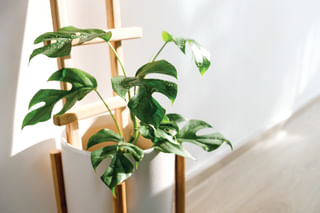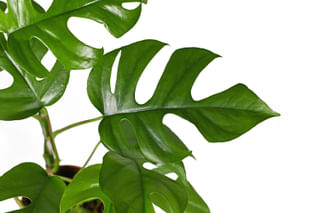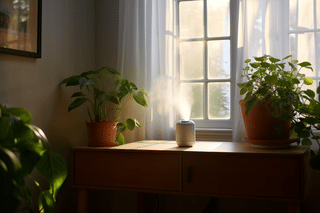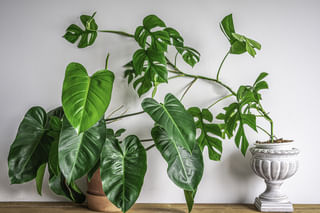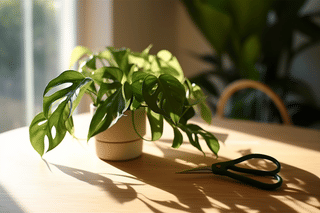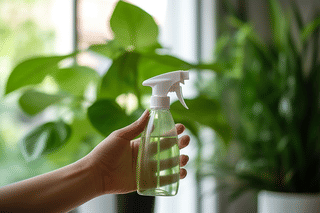How to take care of a Philodendron Minima
The Philodendron Minima is a wonderful climbing Monstera lookalike. In this plant care guide, we're going to look at how you can best take care of your Philodendron Minima and how to help it thrive in your house.
Key learnings from this plant care guide
- Water your Philodendron Minima once per week in the spring and summer, allowing the soil to dry out in between.
- Place your Philodendron Minima in a spot with indirect sunlight exposure, avoiding direct sunlight that can damage the leaves.
- Maintain a temperature range of 15 to 29 degrees Celsius (60 to 85 F) and protect your plant from extreme weather conditions.
- Provide a humidity level of 60 to 70 percent for your Philodendron Minima through misting, using a tray of water, or grouping it with other plants.
The Philodendron Minima is a perfect mix between a Philodendron and a Monstera. It has the large and beautiful leaves of the Monstera, but they grow vines like a Philodendron. It looks a lot like a Monstera Deliciosa, so it makes sense that its nickname is "Mini Monstera". Its leaves might look a lot like Monstera leaves, but there is a slight difference: The holes are much larger, the leaves aren't symmetrical, and the plant is a lot smaller.
In this plant care guide, we're going to explore how to take care of your Philodendron Minima. If you've taken care of other Philodendrons before, taking care of this plant will be very straightforward. These are the topics we're going to look at in this plant care guide:
Let's get started and learn to take care of your Philodendron Minima to help it thrive and turn your living room into a jungle.
Watering your Philodendron Minima
Watering your Philodendron Minima is one of the most important things to make your plant happy. Your Philodendron Minima has long vines that contain a lot of moisture to help your plant grow. This is important to remember because it tells you something about how often you should water your Philodendron.
Your Philodendron stores quite a bit of moisture in its vines, so it's important to let the soil dry out in between waterings. Its watering needs are very similar to what you're used to if you've taken care of a Philodendron or Monstera before. On average, you should water your plant once per week in the spring and summer. This keeps the soil moist for a few days but also lets it dry out.
Watering your Philodendron Minima in the winter
In the winter, when your Philodendron Minima is dormant, you won't have to water your plant as often as you did in the spring and summer.
Since your Philodendron is dormant and recovering from the growing season, you won't have to water it as much. On average, you should water the Philodendron Minima half as much as you did in the spring and summer.
For example, if in the spring and summer, you watered your Philodendron once every 7 days on average, in the fall and winter, this should be once every 14 days.
Sunlight for your Philodendron Minima
Watering is the most important thing for your plant, but sunlight exposure is a close second. When you place your Philodendron Minima in a spot that has the perfect sunlight exposure for your plant, you'll see it become happier and healthier.
Your Philodendron Minima is happiest in a spot that has indirect sunlight exposure. Indirect sunlight means that your plant doesn't get any direct sunlight on its leaves through a window. Direct sunlight will leave burn marks on your plant or make its environment too warm for it to be happy.
The perfect place for your Philodendron Minima is a spot in the middle of a room with a south or west-facing window.
You can read more about the type of sunlight each direction gives you in "Does the sunlight direction matter for your houseplant?".
Sunlight exposure for your Philodendron Minima in the winter
In the winter, the sun isn't as strong and lower in the sky during the day. This means that there is less sunlight coming in through the windows and your house is darker during the day.
This means that you should move your Philodendron Minima closer to the windows to give it a bit of extra sunlight exposure. During the growing season, this sunlight is often too harsh, but it's fine during the winter.
Temperature requirements for your Philodendron Minima
Philodendron Minima is a houseplant that will thrive in a wide range of temperatures. However, there are a few things to keep in mind about the temperature of your Philodendron Minima.
Philodendron Minimas prefer temperatures between 15 to 29 degrees Celsius ( 60 to 85 F). This temperature range is quite large, making it easy to maintain a comfortable environment for your plant.
However, sudden changes in temperature and extreme weather conditions can cause stress and damage to the plant, especially during the winter months. It's also important during summer to protect your Philodendron Minima from direct sunlight and high temperatures, which can cause the leaves to yellow and get sunburned.
Temperature requirements for your Philodendron Minima in winter
During winter, it's best to keep your Philodendron Minima away from cold drafts, like air conditioning units or windows, and keep the temperature above 13 degrees Celsius (55 F).
This colder temperature and fewer hours of sunlight per day will most likely make your plant go dormant for the winter, but it'll "wake" back up in the spring. So if you see little to no growth on your plant during the winter, there is no problem, the plant is just dormant.
Humidity preferences for your Philodendron Minima
Philodendron Minima is a tropical plant that thrives in humid environments. It prefers a humidity level of 60 to 70 percent, which helps to keep its leaves healthy and glossy.
There are a few ways to increase the humidity surrounding your Philodendron Minima if the environment is too dry. One simple method is to mist the leaves regularly using a spray bottle filled with water. This mimics the natural moisture in the air that the plant would receive in its native environment. You can also place a tray of water near the plant or use a humidifier to raise the moisture levels in the air.
Another way to increase humidity is to group your Philodendron Minima with other plants. Plants release moisture into the air through a process called transpiration, which can help to raise the humidity levels in the surrounding area.
As we've discovered in the previous section, the Philodendron Minima is sensitive to cold drafts and temperature changes. These drafts can have an impact on the humidity in the air and the cold air can damage the plant, so it's best to keep them away from these drafts, especially in the winter.
The perfect soil for your Philodendron Minima
We've already learned a lot about watering and sunlight exposure, so let's move on to the next most important thing about taking care of your Philodendron Minima: Soil.
You've already discovered that Philodendron Minima's like to be watered occasionally, but also want to dry out in between waterings, so we'll need soil that can hold onto moisture for a few days and then dry out.
A great soil mix for this would be a general potting soil with some coconut fibers and perlite. This mixture is great for retaining water for a few days but draining excess moisture to the bottom of the pot. The Coconut fibers help to keep the soil nice and light over time, so plenty of oxygen can reach your Philodendron's roots.
This light soil helps to prevent root rot due to the free flow of oxygen to your plant's roots and the excellent draining properties this fluffy soil has.
Fertilizing your Philodendron Minima
A plant needs energy to grow big and strong. Your Philodendron Minima gets this energy from the nutrients in the soil.
When you purchase a brand-new bag of soil from the garden center, it's most likely filled with fertilizer for the first 100 days. So when you repot your Philodendron Minima or just bought your Philodendron Minima, you won't have to feed your plant for the first 100 days. After this time you will have to fertilize your houseplant to keep it strong and healthy.
A Philodendron Minima is a houseplant that you'll need to fertilize occasionally to grow properly. Your Philodendron Minima grows quite quickly in the spring and summer, so you'll need to fertilize it during this period in the year. You can help the Philodendron Minima stay healthy by fertilizing it once per month in the spring and summer. The easiest way to fertilize your plant is to use a liquid fertilizer or fertilizer tablets that dissolve in the water.
You can read more about which fertilizer is best in "What is the best type of fertilizer for houseplants?".
Fertilizing your Philodendron Minima in the winter
In the winter, when your Philodendron Minima is dormant and it's not growing (as quickly), you shouldn't fertilize it at all. The Philodendron Minima won't use the fertilizer during this time, so it'll stay behind in the pot. Over time, this will make the soil very acidic. Your plant can't survive in this type of soil, so it's best to wait until the spring to fertilize your plant again.
How do you remove excess fertilizer from the soil?
If you do find traces of the salts from the fertilizer in the soil, you can flush them out quite easily to help the plant stay healthy. You can recognize the salts by looking for small white salt grains lying on top of the soil.
You can flush these out with a watering can and thoroughly water your plant, letting the water drain from the drainage holes in the pot. You will have to water your plant for much longer than you're used to because you want all the excess salt to escape from the pot. I usually do this for 60 seconds or so.
After which you can let the excess moisture drain from the pot for 10 minutes and you've removed most of the excess salt from the soil successfully.
Pruning and maintenance of your Philodendron Minima
The Philodendron Minima is an incredible plant, but can quickly get out of control and become wild if it is not pruned regularly. Pruning is essential to maintain its shape, encourage new growth, and prevent overgrowth.
The best time to prune your Philodendron Minima is in the late winter or early spring when the plant is just coming out of its dormant phase. This is when new growth will be encouraged the most. Before beginning, make sure that you have clean, sharp pruning tools like loopers or shears to avoid injuring the plant.
Start by identifying the dead, damaged, or yellowing leaves on the plant. These should be removed first. Next, look for any stems that are growing too long or are crossing over other stems and causing congestion. These stems should be cut back to just above a healthy leaf node or intersection. Always make your cuts at an angle, just above a leaf node, to encourage new growth and prevent stem rot.
Philodendron Minima can be prone to overgrowth or "legginess" if it isn't pruned regularly. This can result in long, thin stems and very little leaves. To avoid this, pinch off new growth tips after they develop 2-3 leaves. This will encourage the plant to produce multiple stems and become bushier.
Propagation techniques for your Philodendron Minima
Propagating a Philodendron Minima is quite easy and can be done through stem cuttings. In this section, we will provide you with step-by-step instructions for the successful propagation of Philodendron Minima.
Whenever I propagate houseplants, I do this in water rather than soil, so that's what I'll highlight in this section.
Step 1: Prepare the cutting
The first step to propagating your Philodendron Minima is to select the perfect stem cutting. Choose a healthy stem with a few leaves on it. Make sure that the stem has at least one node. The new roots will grow from this node.
Step 2: Cut the stem
Using a clean, sharp pair of scissors or a knife, cut the stem just below the root node. Make sure to make a clean cut to minimize damage to the cutting and the plant. A clean cut will also reduce the chance of the cutting starting to rot.
Step 3: Remove the lower leaves
Remove the lower leaves from the stem cutting, leaving only a few leaves at the top. This will help the cutting direct energy to root growth instead of leaf production.
Step 4: Place the cutting in water
Fill a small jar with water and place the cutting in the water. Make sure none of the leaves are touching the water as this can cause the leaf to rot and affect the health of your cutting.
Step 6: Monitor the cutting
Check the cutting regularly for any signs of growth or problems. It should take a few weeks for the cutting to start growing new leaves and, eventually, roots. Once the plant has developed a sufficient root system, you can move it into a pot with soil.
Is your Philodendron Minima toxic for pets?
Some plants are toxic for your pets and people and should be kept away from pets and small children. You might ask yourself if your Philodendron Minima is one of these plants that's toxic to your pets and children.
Your Philodendron Minima is somewhat toxic to your pets and children, so you should still keep your Philodendron Minima away from them. Luckily, it's only bad for your children and pets if they chew on the stems and it's not harmful if they only touch the plant. If you've noticed that your children or pets have eaten this plant, make sure to call the doctor or veterinarian.
Pest control for your Philodendron Minima
Like any other plant, the Philodendron Minima is prone to pests that can weaken and damage the leaves. To keep your plant healthy and thriving, it's important to identify and treat these pests quickly.
Spider mites
One of the most common pests that can affect a Philodendron Minima is spider mites. These tiny creatures are barely visible to the naked eye but can cause a lot of damage if left uncontrolled. Signs of spider mite infestation include webbing between the plant's leaves, discoloration, and distortion of the leaves.
To control spider mites, you can start by spraying the plant with a strong stream of water to wash away the webbing and mites. Another option is to mix rubbing alcohol and water in a 1:1 ratio and apply the solution with a cotton ball to the underside of the leaves. Repeat these treatments every few days until the infestation is gone.
Aphids
Another common pest that can harm your Philodendron Minima is aphids. These soft-bodied insects are usually found clustered on the new growth of the plant and they can cause leaves to curl and distort. To get rid of aphids, you can make a solution of water and dish soap in a spray bottle and apply it to the affected leaves. You can also introduce natural predators like ladybugs to your plant to control the infestation.
Chemical pest solutions
If natural remedies don't work, you can always opt for chemical solutions. However, these should be your last option, as they can also hurt your plant. So try natural solutions first and only go for the chemical option if nothing else works.
Conclusion
In this plant care guide, we've looked at how you can take care of your Philodendron Minima. We've looked at how to water your Philodendron Minima, the best sunlight exposure for the Philodendron Minima, the best soil for Philodendron Minimas, how to best fertilize your Philodendron Minima, and whether the Philodendron Minima is safe for your pets and kids.
Thank you for reading this post! I hope it helps you to keep your plants healthy and beautiful! If you're looking for more guides on specific plants, you can always request a plant guide to get a guide for the plant you have trouble with.
Test your plant care knowledge
Quiz completed!
Want to learn more? Sign up for my newsletter to receive free tips in your inbox!
Sign up now!